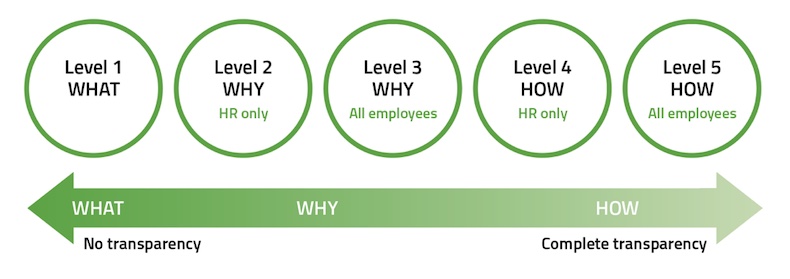Why pay transparency is about more than just revealing what someone earns
The phrase pay transparency is often misunderstood. When we think about pay transparency or hear about it in the media, the subject is actually pay disclosure: in other words, revealing the salaries of our employees. When we think of transparency in these terms, we devalue its wide-ranging benefits, such as building trust, establishing fairness, and encouraging innovation.
Transparency is about giving people context.
Giving out salary information without context is like grading a test paper without marking which answers were right and wrong, so the student doesn’t know what earned them the grade they achieved.
Being clear about decisions
When it comes to pay, transparency means being clear and open about how and why compensation decisions are made. Pay is by no means a one-dimensional process; there are many factors that determine how we pay our employees, such as:
• Skills and capabilities
• Task complexity
• Performance
• External market
• Your position against the market (eg median, upper quartile)
• Internal equity
• Affordability
Measuring these factors in organisations is difficult – and often subjective. How do we measure performance, for example? If performance influences pay, then how can we ensure that leaders manage performance fairly and consistently?
If we want to look at the external market, what data should we use? Industry-specific or all industries? Is that the same for all roles or are some roles different to others? If we publish salaries or pay ranges, should we offer training to everyone in our organisation around how salary surveys are compiled and how to benchmark?
Disclosure is personal
Then there is the question of privacy. How many of us tell our friends and family how much we earn? Would we want to tell our colleagues? Research from the Fawcett Society found that around half of us would feel uncomfortable disclosing our salary to a peer. In which case, shouldn’t disclosing our salaries be a personal decision rather than having that decision made unilaterally by the organisation?
So pay transparency doesn’t mean we have to publish everyone’s salaries, but we do need to be clear about how and why pay decisions are made. People want to know there is a sound process based on fairness and consistency. They want to know that their livelihoods are not subject to bias or the gut feeling of their line manager.
We find it helpful to view pay transparency in the context of a five-point pay transparency scale.

This transparency scale splits our approach to pay into three categories:
• What do you pay your employees?
• Why do you manage pay the way you do?
• How do you make pay decisions?
Level 1 is where we know what we pay our employees and this is clearly communicated to them. Everyone knows their monthly salary. But do they know the different benefits available to them? Are they aware of the value of those benefits, such as through a total reward statement? This is where almost all organisations start.
Level 2 looks at why we manage pay a certain way. What are your reward principles and strategy? What is the purpose of pay? Why should it progress? Is it linked to performance, skills, or contribution?
Level 3 is where the why is communicated across the organisation so employees understand the overall reward principles underpinning everything they do. They understand why their pay is managed a certain way.
Level 4 is when we start thinking about how we make pay decisions. Some organisations may have an approach to job evaluation, a career framework and a pay structure in place, but they are only used within HR and finance.
Level 5 communicates these reward frameworks across the organisation, so employees know how pay decisions are made. They know how their role fits into the career framework and how their salary fits into the organisational pay structure. They also know what is expected of them and how their pay will progress as they advance within the organisation.
Not all organisations will move in this direction from Level 1 to 5. Each organisation is different, but the scale offers a guide for moving towards more pay transparency. It also illustrates that moving towards pay transparency is a gradual process: a significant cultural change that requires time, clear communication, and stakeholder management. Making a sudden shift without clear communication could do more harm than good.
We should all aspire to reach Level 5. Competitor salary data is just a Google search away. Websites like Glassdoor allow people to get a good understanding of market pay rates and this is only going to become more common. We can’t continue to allow managers to make decisions that affect the livelihoods of our colleagues based on gut feelings.
Supplied by REBA Associate Member, 3R Strategy
We help you attract and retain your people through a fair and equitable approach to pay and reward.








